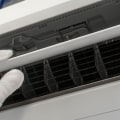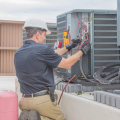It's essential to inspect your air conditioner annually and replace the insulation if needed. There are a variety of insulation materials available, each with their own pros and cons. Aerosol foam insulation is a popular choice in HVAC systems due to its versatility and ease of installation. It has a high operating temperature and excellent moisture resistance, making it suitable for use in both hot and cold climates.
It also has a high fire resistance index, making it ideal for use in commercial or industrial applications. Rigid fiber or fibrous plate insulation consists of fiberglass or mineral wool material and is mainly used to insulate household air ducts. It is also used when you need insulation that can withstand high temperatures. These products come in a thickness range from 1 inch to 2.5 inches.
Refrigeration lines use various types of insulation. Common materials for air conditioner insulation wrap include foam rubber, polyethylene foam, and fiberglass. Among these, the best balance between cost and effectiveness is found in polyethylene foam products. These have closed-cell designs to prevent moisture from entering. Once you have the measurements, you can go to any home improvement store in your area and buy a new insulator for air conditioning pipes.
Blanket-type insulation, the most common and widely available type of insulation, comes in the form of blocks or rolls. It is more effective to install insulation on the surface of the blocks, either outside or inside the foundation walls. You can also rent a machine and do it yourself, but I strongly recommend that you don't because a wrong move could affect air quality or electricity bills. This lack of insulation in refrigerant lines can negatively affect the overall functionality of a typical residential air conditioner.
To evaluate the types of insulation sprayed or blown, measure the depth of the insulation and check for gaps in the roof. However, field studies and computer simulations have shown that any type of filling with a core saves little fuel, since heat easily passes through solid parts of walls. Placing the insulation outside has the added advantage of containing the thermal mass of the blocks inside the conditioned space, which can moderate indoor temperatures. The hot roofing material then radiates the accumulated thermal energy to the cooler surfaces of the attic, including the air ducts and the attic floor.
If the air conditioner is on, turn it off to increase the temperature of the suction pipe until it no longer generates condensation outside after wiping it with a towel. If you bought covers without slits, cut through one side of the insulation to the center of each cut piece. Different types of insulation are available for different applications, such as ducts, pipes, and walls. To achieve maximum energy efficiency and save costs, it's important to choose the right type of insulation for your air conditioning system and your specific needs.
However, foam insulation has higher R values and forms an air barrier, which can eliminate some of the other costs and tasks related to cooling a home, such as caulking, applying a coating layer and a vapor barrier, and gluing joints with adhesive tape. In conclusion, there are many types of HVAC insulators available on the market, each with their own advantages and disadvantages. When selecting an insulator for your air conditioner maintenance needs, consider factors such as cost-effectiveness, fire resistance index, moisture resistance level, operating temperature range, thickness range, and ease of installation.


